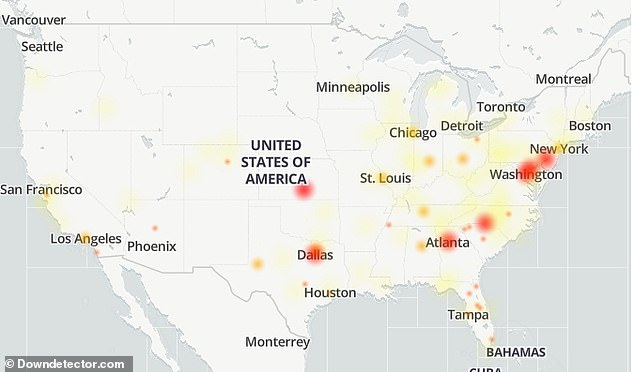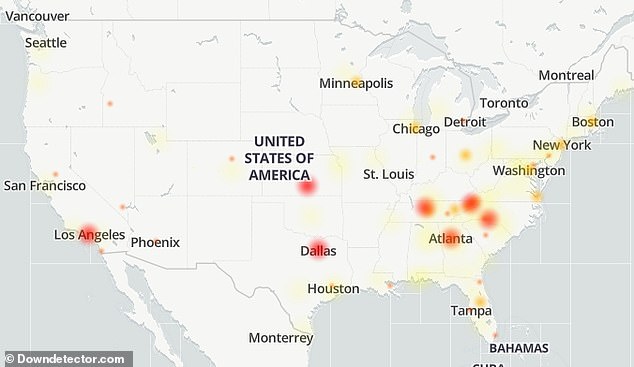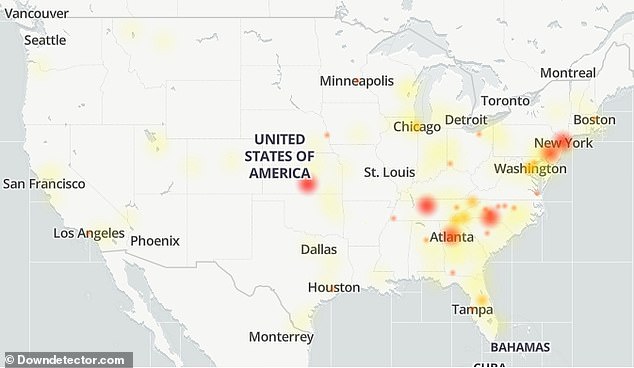Verizon customers were in an uproar after the cell phone carrier’s service was cut off Monday morning.
The outage potentially affected millions of customers who reported they could not make or receive calls or text messages and only had an SOS signal.
AT&T and T-Mobile faced similar challenges: Users complained that they couldn’t access their 5G network and that their phone wouldn’t connect to WiFi.
Although AT&T and T-Mobile’s outage appeared to be limited to the Southeast coast in areas devastated by Hurricane Helene, Verizon complaints spiked in the Midwest.
The outage continued into the early evening, although Verizon said the issue was beginning to resolve in some areas.
Verizon users across the country were affected by the outage, but most were located in the Midwest. Customers complained that their phones were set to SOS mode and they were unable to send or receive calls or text messages.

Verizon, AT&T and T-Mobile customers complained of phone outages on Monday
Reports that Verizon was down began around 9:30 a.m. ET with customers complaining that their cell service was completely down.
Customers spanning the entire United States, from Phoenix, Arizona to New York City, said they were only receiving an SOS signal.
However, those affected appear to be located primarily in the Midwest and people claim the outage started at different times for each of their family members’ devices.
People in Indiana, Illinois and Wisconsin complained that their phones were locked in SOS mode, which only allows emergency calls via satellite.
One person posted on Downdetector, a site that monitors online problems, that “text over WiFi is not enabled for some reason and I can’t get into the settings to turn it on.”
Another person said they experienced a complete blackout in Sacramento, California, with no access to calls, texts, or data.
The cell phone operator responded to some comments and asked for additional information from anyone who said their phone was locked in SOS mode.
‘I know I would share your concern if my phone was on SOS too. I’m here to help analyze this and help find a solution.’ said a response.
Verizon asked the user: ‘When did this problem start occurring? Can you share with us the nearest street intersection and the city where this is happening? Please DM.’
It is still unclear why people in the Midwest were hardest hit by the outage and a Verizon spokesperson told DailyMail.com that they are aware of the issue and their “engineers are engaged and we are working quickly to identify and resolve the issue.” .
The company later posted the same message on X.

AT&T users reported that they were also affected by the outage, complaining that they could not send or receive calls or text messages and that their phones would not connect to WiFi. These people were mostly in areas affected by Hurricane Helene.

T-Mobile users on the Southeast Coast reported they couldn’t use their 5G or connect to WiFi
AT&T and T-Mobile customers also reported an outage, saying they couldn’t send or receive calls or texts or access their WiFi.
According to a T-Mobile spokesperson, those living in the Southeast, where Hurricane Helene hit last week, were primarily affected.
Heat maps on Downdetector show that most user outage reports are coming from parts of Florida, Georgia, Tennessee and the Carolinas, all states that were affected by Hurricane Helene last week.
However, the disruption could be more widespread because those affected may not report their experiences.
A T-Mobile spokesperson told DailyMail.com that “based on the increase in reports of Down Detector related to other carriers, we believe our customers may be having difficulty connecting to other networks.”
They added: “Outside of some areas where restoration continues following Hurricane Helene, our network is operating normally.”
However, an AT&T spokesperson stated in an email to DailyMail.com that the company is not experiencing a major outage and that its “nationwide network is operating normally.”
They added: “Down Detector is likely to reflect the challenges our customers face when trying to connect with users on another network.”


